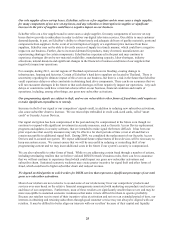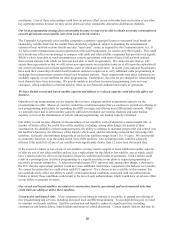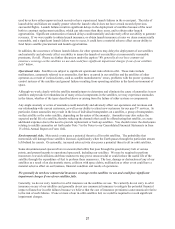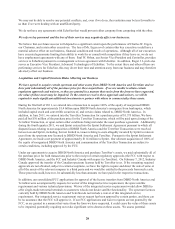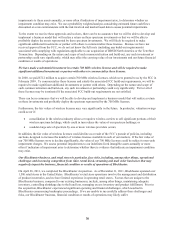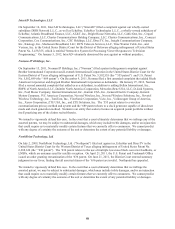Dish Network 2011 Annual Report Download - page 40
Download and view the complete annual report
Please find page 40 of the 2011 Dish Network annual report below. You can navigate through the pages in the report by either clicking on the pages listed below, or by using the keyword search tool below to find specific information within the annual report.30
30
impairments to these assets annually, or more often if indicators of impairment arise, to determine whether an
impairment condition may exist. We use a probability weighted analysis considering estimated future cash flows
discounted at a rate commensurate with the risk involved and market based data to assess potential impairments.
To the extent we receive these approvals and waivers, there can be no assurance that we will be able to develop and
implement a business model that will realize a return on these spectrum investments or that we will be able to
profitably deploy the assets represented by these spectrum investments. We will likely be required to make
significant additional investments or partner with others to commercialize these licenses. Because we have not
received approval from the FCC, we do not yet know the full costs (including any build-out requirements)
associated with complying with regulations applicable to our acquisition of DBSD North America or the TerreStar
Transaction. Depending on the nature and scope of such commercialization and build-out, any such investment or
partnership could vary significantly, which may affect the carrying value of our investments and our future financial
condition or results of operations.
We have made a substantial investment in certain 700 MHz wireless licenses and will be required to make
significant additional investments or partner with others to commercialize these licenses.
In 2008, we paid $712 million to acquire certain 700 MHz wireless licenses, which were granted to us by the FCC in
February 2009. To commercialize these licenses and satisfy the associated FCC build-out requirements, we will be
required to make significant additional investments or partner with others. Depending on the nature and scope of
such commercialization and build-out, any such investment or partnership could vary significantly. Part or all of
these licenses may be terminated if the associated FCC build-out requirements are not satisfied.
There can be no assurance that we will be able to develop and implement a business model that will realize a return
on these investments and profitably deploy the spectrum represented by the 700 MHz licenses.
Furthermore, the fair values of wireless licenses may vary significantly in the future. In particular, valuation swings
could occur if:
x consolidation in the wireless industry allows or requires wireless carriers to sell significant portions of their
wireless spectrum holdings, which could in turn reduce the value of our spectrum holdings; or
x a sudden large sale of spectrum by one or more wireless providers occurs.
In addition, the fair value of wireless licenses could decline as a result of the FCC’s pursuit of policies, including
auctions, designed to increase the number of wireless licenses available in each of our markets. If the fair value of
our 700 MHz licenses were to decline significantly, the value of our 700 MHz licenses could be subject to non-cash
impairment charges. We assess potential impairments to our indefinite-lived intangible assets annually or more
often if indicators of impairment arise to determine whether there is evidence that indicate an impairment condition
may exist.
Our Blockbuster business, and retail stores in particular, face risks, including, among other things, operational
challenges and increasing competition from video rental kiosk, streaming and mail order businesses that may
negatively impact the business, financial condition or results of operations of Blockbuster.
On April 26, 2011, we completed the Blockbuster Acquisition. As of December 31, 2011, Blockbuster operated over
1,500 retail stores in the United States. Blockbuster’s retail store operations involve the management and distribution
of product inventories, and we have limited experience in operating retail stores. Factors that are unique to the
Blockbuster business, compared to our existing businesses, include, among other things, maintaining adequate
inventory, controlling shrinkage due to theft and loss, managing excess inventory and product fulfillment. Prior to
the acquisition, Blockbuster experienced significant operating and financial challenges, which resulted in
Blockbuster commencing bankruptcy proceedings. If we are unable to successfully address these challenges and
risks, our Blockbuster business, financial condition or results of operations may likely suffer.







